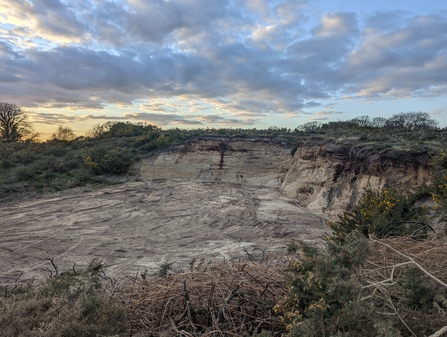Weekly wild news from our reserves - 18 March 2022
Heathland restoration - Jamie Smith
The West Suffolk team got together at Lackford Lakes this week to assemble and launch a tern raft into the Slough. A tern raft is a floating raft that is kept in place with a rope and anchor. The structure is primarily intended for terns to nest on, but a variety of other species like black headed gulls, great crested grebe and oystercatcher will also benefit.
Amorous amphibians
Love is in the air (or water!) across our ponds and wetlands, with lots of frogspawn appearing and toads pairing up.
Observation tram
Thanks to some amazing Trust supporters and match-funding from Defra, Green Recovery Challenge Fund we have now opened our lovely double-decker viewpoint at Lackford Lakes. We’ve had extremely positive feedback from visitors including suggestions we rename the viewpoint ‘tramcar’ due to its charming distinctive shape!
Habitat restoration
At Blackheath Common an area of thick gorse has recently been scraped off to reveal bare soil, which will subsequently be spread with heather seed as part of heathland restoration work. This new habitat will benefit many heathland species including solitary bees and wasps, beetles, spiders and basking reptiles.

Heathland restoration - Jamie Smith
Also at Blackheath, contractors Barry Day & Sons did a superb job of refacing the sand martin pit, levelling out any slumps in order to discourage predators from climbing up to the birds’ nest holes. Sand martins nest in colonies, digging burrows in steep, sandy cliffs, usually around water, and are commonly found on wetland sites. The tunnels they create can be up to one metre in length. At a chamber at the end of the burrow, four or five eggs are laid on collected straw and feathers. Sand martins are sociable birds and will nest together in summer and gather to roost in large numbers in autumn; eventually they migrate to Africa where they spend the winter.

Sand martin pit – Jamie Smith
A mosaic of structure
The Softrack reed-cutter has recently been in use at Dingle Marshes introducing more structural variety within the reedbed sward. This mosaic of structure will benefit many species and we hope will attract breeding waders such as avocet, lapwing and redshank.

Softrak habitat work at Dingle Marshes – Jamie Smith
Chiffchaff
Warden Jamie recorded this lovely clip of his first chiffchaff of the year at Reydon Wood. The chiffchaff sings its name out loud in a simple 'chiff chaff chiff chaff' song, which it performs from the tree canopy. Some chiffchaffs stay all year-round, but most migrate here from Africa. They are one of our earliest arrivals, singing their hearts out from the end of February onwards.
Withy bed springs to life
Continuing the rejuvenation of the withy bed at Oulton Marshes, following habitat work last week, the nice weather has prompted some young shoots to grow already which will soon provide homes for insects and the birds that eat them. It's a sheltered spot so an ideal sun trap for early invertebrate activity, with recent sightings including small tortoiseshell, red admiral and the comma butterflies.










